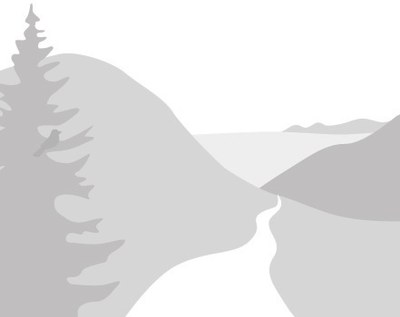
Trip Report
Intermediate Ice Climb - Chair Peak/North Face (winter)
Another pretty tough 16-hour day with a mixture of some fun, and some gnarly moments.
- Sun, Mar 15, 2020
- Intermediate Alpine Climb - Chair Peak/North Face (winter)
- Chair Peak/North Face (winter)
- Climbing
- Successful
-

- Road suitable for all vehicles
-
Approach and descent still requires snowshoes. The snow has some crust in places, but boots easily break through it and result in knee-deep post-holing. Some good plunge-stepping made for an easy ride on descent.
Again some avy debris on approach, including in the chute between Chair and Bryant, as shown on the NWAC picture, and evidence of wind loading and some cracks on the North slopes of Chair. Be very careful venturing into that area.
Knee-deep snow wallowing on part of the approach below the North Face, but most of the terrain is covered with older wind wind-loaded snow that is reasonably easy to travel on.
Ice has formed in a number of areas, including at the base of the North Face, but almost all of that ice is of exceptionally poor quality: either not solid (can push a screw in), or if solid, then filled with air pockets or too thin even for a stubby.
Ice on the first pitch somewhat steep and not super reliable for screws, only got 2 in to protect the pulling over bulges), with some effort finding spots that took screws. Not great, but ok for tools and crampons.
A bit better ice on the upper slope (including a smear for an anchor at the of the first pitch to the left of the route), but very limited.
Snow poorly consolidated, and sketchy to travel on. Loose powder with buried thin crust in places. Picket placements were mostly useless.
Tons of loose snow came down on us in a dozen of mini spindrift avalanches as we were standing on belay, requiring us to duck in for cover.
Rock pro options were near-nonexistent. Most rock covered. Some placements for Knifeblade pitons mostly in the smaller sizes (#2 and thereabouts), mostly down low.
Down-climb to the rappel anchor looked not great in the current snow conditions, not recommended. We chose to double-rappel to the rap anchor from the trees to the left of the gulley between summit traverse and false summit.
Got rope stuck and required climbing back up halfway to unstuck it.
Overall, the current conditions are 50 shades of sketchy. Wait for another time to climb this route.
Once again, the plan was to climb Reid Headwall, and once again, -30C summit chills compounded with high avy danger from recent winds and snowfall forces us to look for alternatives.
Chair was an attractive target, with forecast showing a trend towards improvement. I had climbed the Northeast Buttress just the past weekend (and had a great time), so that wasn't my first choice, but the North Face was still an option, and it's been on my list of things to do for a while.
The main challenge with North Face was the scarcity of beta. Some pictures on summit post and in trip reports here and there, but nothing very recent, and nothing from this season. I tend to do a lot of research in preparing for my trips, so this was going to be as new one for me. A lot of unknowns, and a bit of a stab in the dark.
Fortunately, despite the uncertainty about the outcome, assembling a team of 4 willing to roll the dice and participate in this adventure wasn't too hard.
A post on a social networking site got us in touch with a skier, who did manage to get a reasonably recent picture of the North Face, albeit from very far away. It was impossible to assess conditions of the snow, ice, or prominent features, but it did show a moat formed at the base of the first pitch, and possibly some cornicing on the summit, consistently with what we know from the trip reports. But, that's about all we could discern from it.
The latest snapshot of the forecast before we ventured out was 18F temps and 3F with wind chill at 5am, but warming up throughout the day, mostly clear sky, winds in the ballpark of 10-15mph, and avy risk "low" at and below treeline rising to "moderate" above the treeline, where wind gusts earlier this week may have formed wind-loaded pockets on lee slopes and cross-loaded terrain features.
These weren't the best conditions imaginable, but after a group discussion, we decided to go for it, to carry avy and rescue gear, and to evaluate the terrain carefully as we go.
We hit the trail at 5:15am, similarly to last weekend. Again, we made it to the Source Lake in about 50 minutes.
This time, I opted not to climb to the base of the Northeast buttress just yet, but instead to stop at the flats right above the Thumbtack, and assess the conditions of the ridge that separates the lakes on the off chance that it might be possible to climb over and approach the face from below.
The going was faster than last weekend since we didn't have to break trail, and we got to that spot at about 7:30am, or in about 1.5 hours from the Source Lake.
We enjoyed nice views along the way, with the moon illuminating our route:
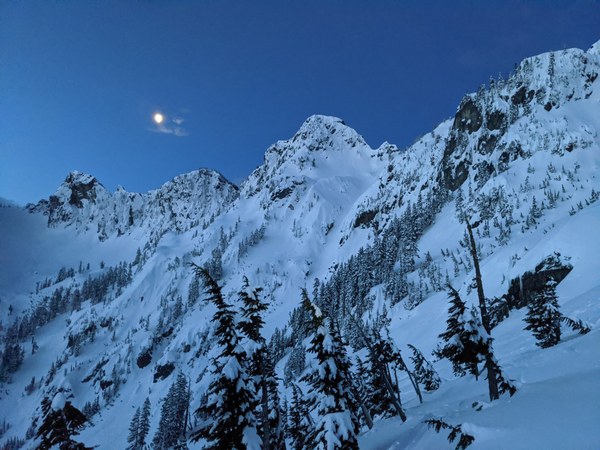
Once again, as soon as Chair Peak popped into view, we got excited:
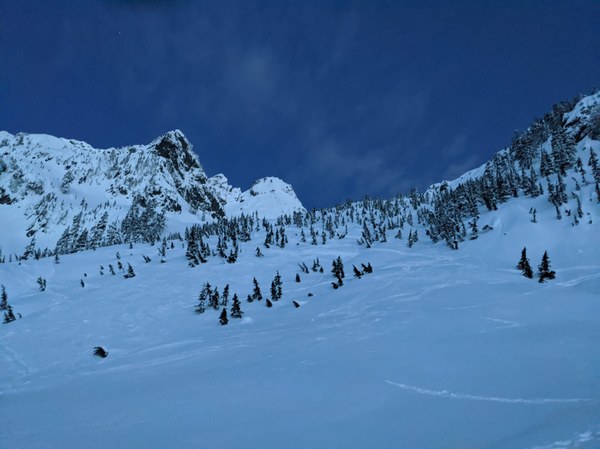
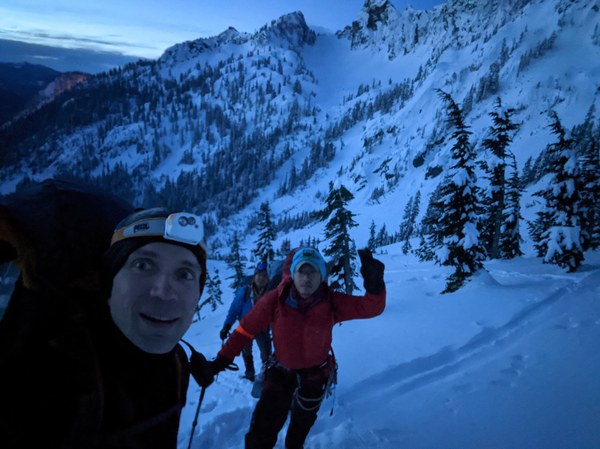
With the sun on the way out, we were greeted to a beautifully clear sky all around:
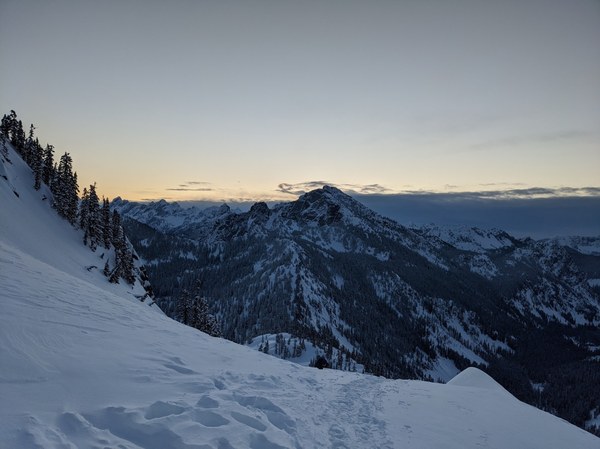
Approaching the peak:
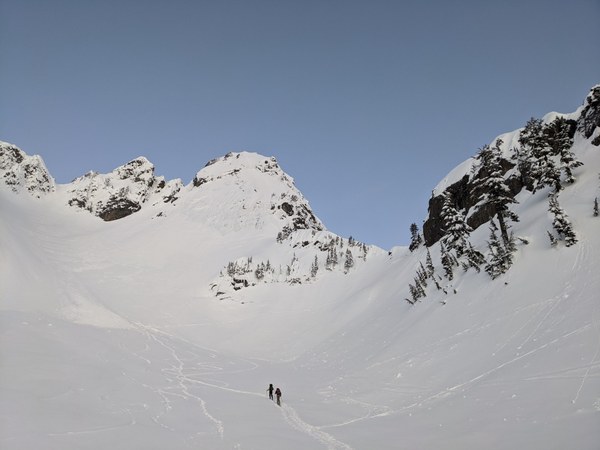
As noted above, we reach our gear stash right above the Thumbtack by 7:30am. The conditions of the snow on the ridge that gets across to the Northern side looked pretty good and with recent skin tracks crossing it. After a brief group discussion, we decided that this is a better bet than moving higher to gear up closer to the base of the NEB and crossing the upper notch. We decided to go for the lower traverse, dumped snowshoes, and started gearing up, which took ~30 minutes.
Fully geared up, but not roped up just yet, we headed out for the notch at about 8am.
Here's our entire climbing route:
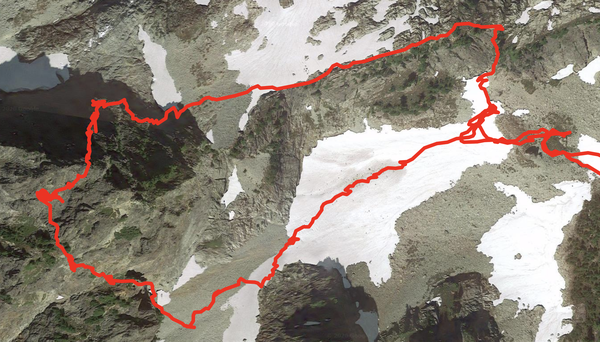
As soon as we cleared the notch, the North Face came into view. We could clearly see the moat at the base. Pending closer inspection, but tentatively decided to go for the traverse above the moat, since it looked pretty wide and corniced, and likely not crossable from down below:
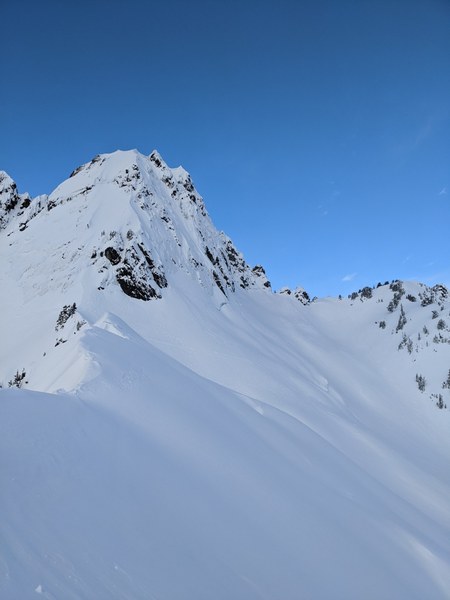
We moved along the ridge at first towards the upper notch, which took 30 minutes, but then had to start traversing towards the face. The going was slow, since the snow was soft and deep in places and we were sinking knee-deep.
Took some pictures of the NEB along the way from a viewpoint I didn't get to explore the preceding weekend:
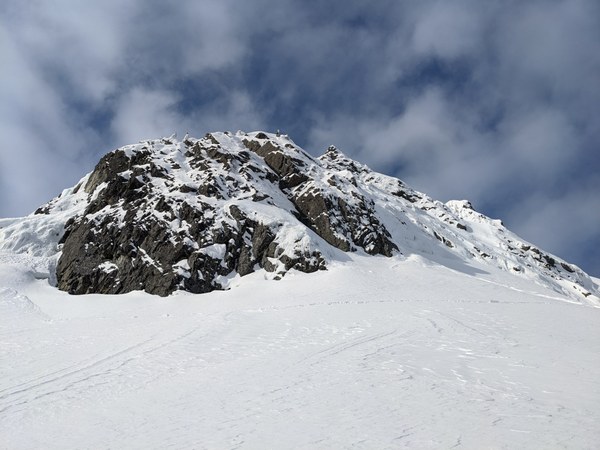
And finally, here's a closer look at the North Face from the approach:
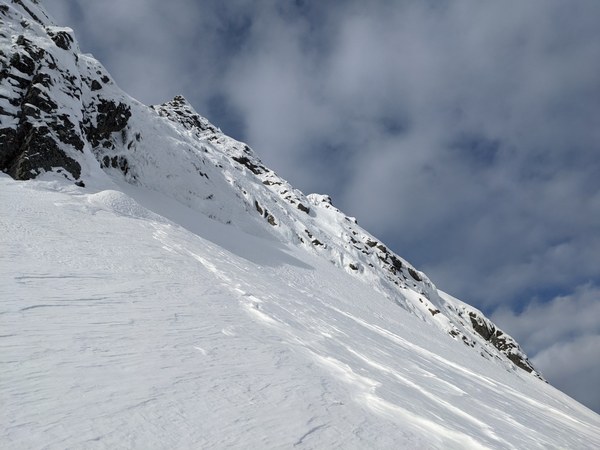
Lots of wind-loaded terrain on the way up, which was a curse and a blessing. We had to be careful where to step, but the hardened surface also helped with forward and upward progress.
Eventually, we got close enough to the base to be able to see conditions on the traverse.
The snow in the lower portion of the traverse looked soft and unreliable, and I didn't feel comfortable doing the traverse unprotected. On the other hand, the bottom of the face had several ice smears and a bit of exposed rock here and there, so I decided to pitch it out, and traverse right below the face, placing pro on the face itself. This meant a little bit of downclimbing around to get around a rock band in the way, but having pro along this long traverse was a priority.
I approached the closest reasonable-looking ice smear. Looked better from the distance than it was in reality, but good enough for a semi-legit/semi-sketchy anchor made out of a pair of 10cm screws.
Soon after, we were all up at the belay, stoked for pitch 0 to finally begin:
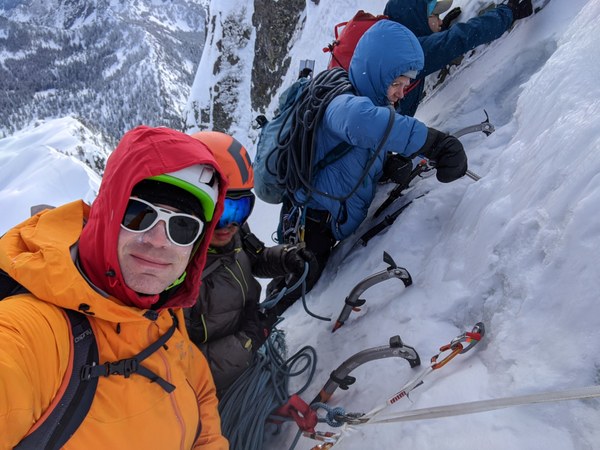
Getting from our gear stash up until this point took exactly an hour. Pitch 0 started at 9am sharp.
Last look at the belay before venturing into the unknown:
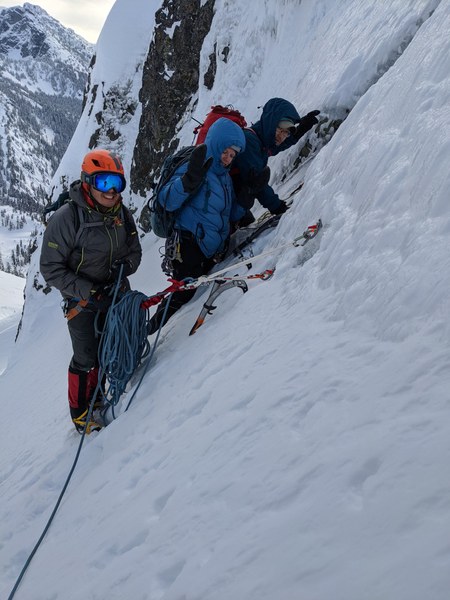
Now, the priority was to put a Jesus pro in. There was a fat-looking smear of ice just about 30 feet away, so I went for it.
Sadly, and this may be the theme of the day, what looked fine from the distance turned out rather poor upon close inspection. The ice was well-formed, but with tons of air pockets. I was unable to place even a stubby without it bottoming out or the threads failing to grab.
I tried to excavate some rock, but failed to find any place to place pro.
So, my Jesus piece ended up being a Spectre pounded into a thicker chunk of ice, extended with a cordelette. Uhm, a great start... and great way to reset expectations for things to come.
My second piece further down the face ended up being a #2 Knifeblade piton. The rock looked not so great at first, but as I hammered it, it gave out a beautiful clean ring. It felt good, and it was by far the best pro I placed during the day. And certainly, the only one I would take a whipper on.
My third and final piece was a 10cm screw in a smear of crappy ice right next to the arete that we were going to climb that constituted the first pitch. Not a lot of pro for a full 70m of the traverse, and I just maxed out on the rope as I touched the rock corner at the base of the pitch. Bringing the 70m ropes definitely helped on this climb.
Constructing the belay was not easy. The ice was mostly of poor quality, and the adjacent rock did not offer nearly as many pro options as advertised. The ice was a bit better in the middle of the ice smear, but a lot of spindrift was coming down from above, getting funneled by the rock arete onto the belayer. I had to construct the belay right by the rock face in a slightly more sheltered spot that didn't get pounded nearly as much. But, the ice and snow right by the rock was softer, and getting good pro was harder to find.
My belay anchor ended up being as 10cm screw, and a small nut in the rock. Not great, but you take what you get.
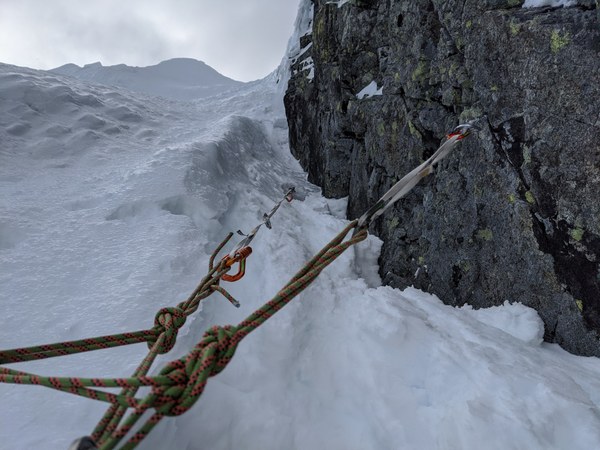
Looking back from the belay at the traverse:
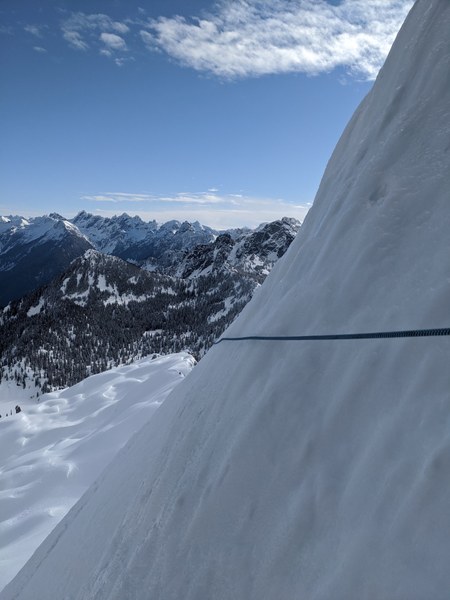
With the scarce pro options, the traverse took half an hour or so. In order to save time, the follower didn't collect pro, and left it for the second team to reuse, especially as they did't carry pitons or Spectre, and might not be able to protected the traverse otherwise. Concerned about conditions higher up, I really wanted my Spectre and my #2 Knifeblade back, so we had to wait for both teams to traverse before starting pitch 1 proper, which all in total took another 10 minutes or so.
In retrospect, given the conditions I think pitons are must on this route, and a separate set should be carried by every rope team. I will definitely be getting more pitons for future winter climbs, and given this experience, I feel they are definitely worth the extra weight.
Started the first proper pitch at somewhere in the ballpark of 9:40am. The ice in the middle of the flow was better, so I moved along the centre. Not great for screws, but at least upwards progress was possible. Fairly steep with some bulges, I'd say in the ballpark of AI2+. With some effort, I did manage to protect pulling over bulges with a pair of 10cm screws. Couldn't place pro in the rock, since ice near to the rock was bad, and I didn't feel comfortable getting near.
After clearing the rock arete, I topped out on steep snow. Pickets in the snow that we had were not useful, and there was no ice or rock to put place pro in right where I was. But, I did see what looked like a small smear of ice on the snow about 30-40 feet or so above and to my left. I decided to go for it, and just hope that it turns out to be good enough for a belay.
The smear took short screws, and I was able to put in a semi-legit 3-point anchor:
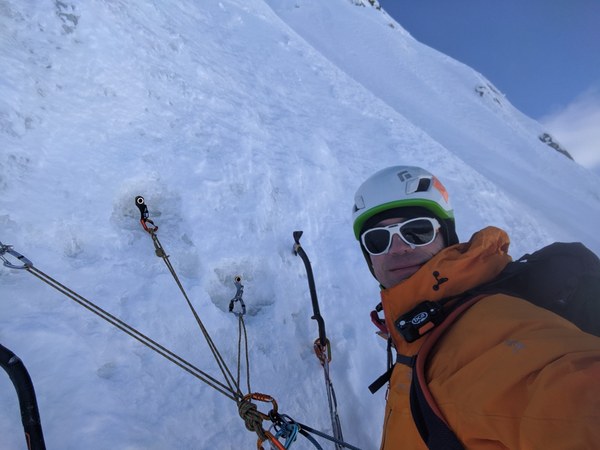
Later added two more screws, as I wasn't feeling confident in the quality of the ice. The slope on which the first pitch ended was pretty darn steep, an the quality of the snow did not inspire too much confidence:
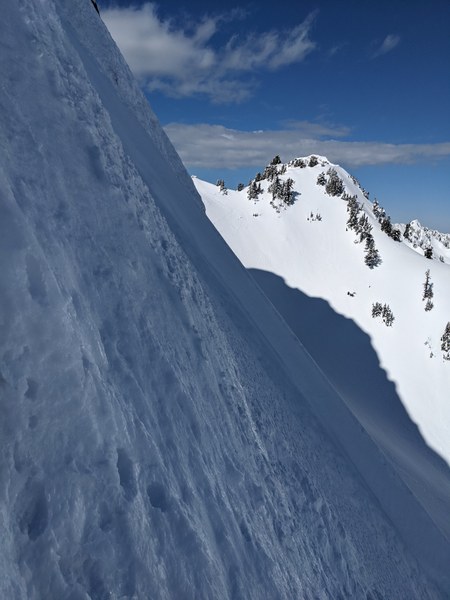
Soon after I built an anchor, another group following us topped out and built an anchor right next to mine. Always good to have company:
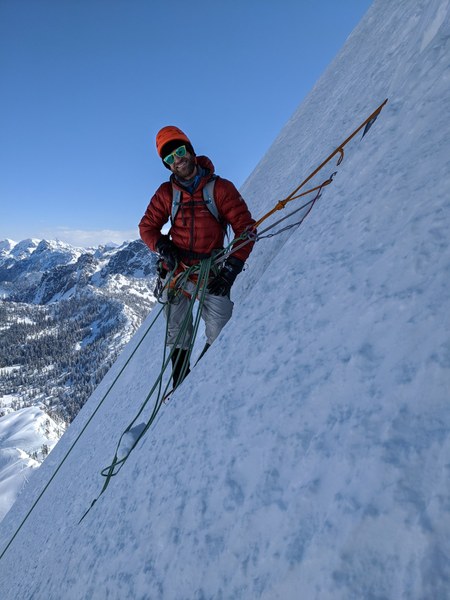
Great views all around:
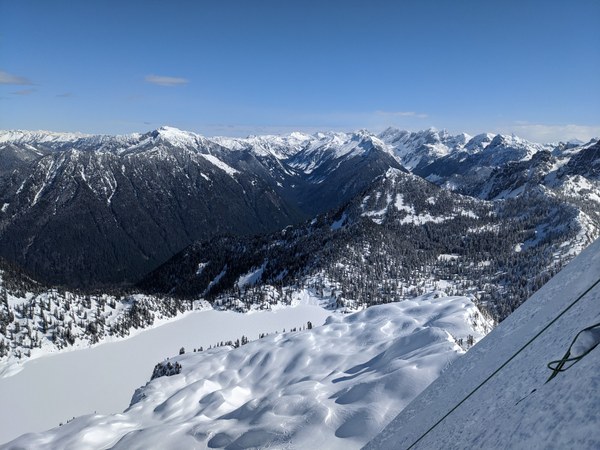
Looking back at the first pitch:
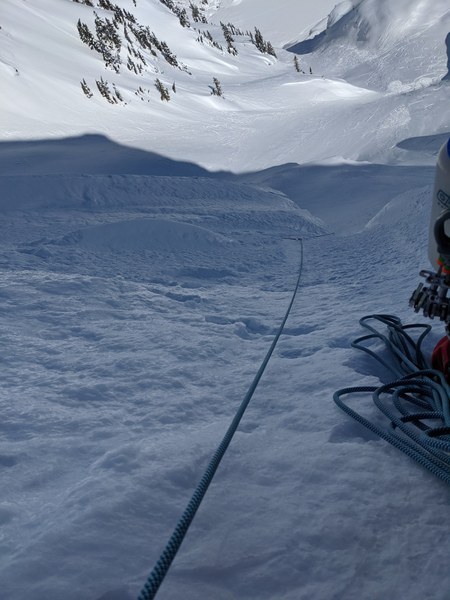
Soon after, my second was up, and went on to climb the next pitch. Now, from the belay station, I could see the tree to the right of us that we would be aiming for on the second pitch:
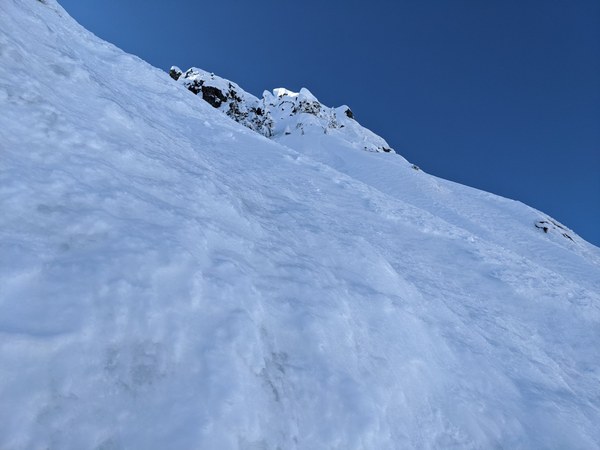
However, the party climbing next to us took the left line, to a different tree that was much closer than the tree across the slope. My second followed.
This initially seemed like a good idea, and I was grateful for not having to spend too much time on my hanging belay. It still felt like an eternity. During the time we were hanging at the top of the first pitch, we got bombarded by a dozen or so dry mini-avalanches, each dumping a ton of loose spindrift snow on us. That powder would keep trying to get everywhere: in the open pocket of the backpack, in the gap between my jackets behind my neck. We had to keep clinging to the slope and duck for cover to avoid it.
Finally, I was put on belay and son enough, and soon enough, I met my second at the tree. Halfway done... or so it seemed:
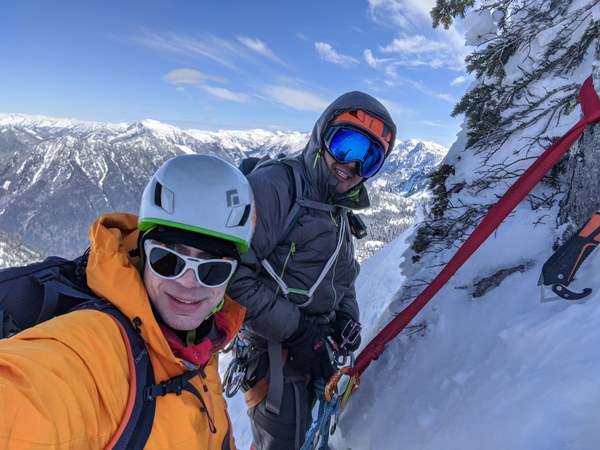
The other team followed right behind. Looking back at the second pitch:
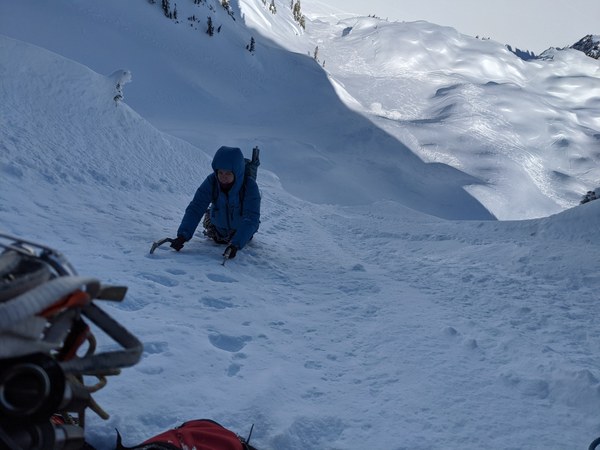
Now, it was my turn again to lead the third pitch. Looking up, with a beautiful ice step right in the middle:
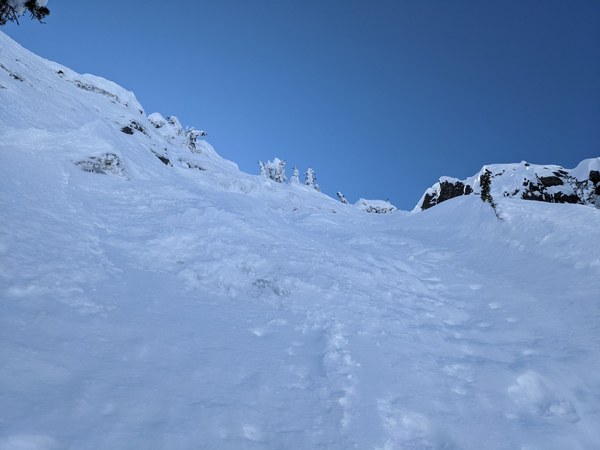
Now, this is where things got interesting.
I remember from reading the beta that the second pitch aimed at a tree on the right side of the slope (the one I looked at, above, but not the one we took). The third pitch was supposed to go to a tree on the left, and across an ice step.
Was the ice step that I was looking at the ice step in question? I didn't have a good picture, and at first, I thought so. It looked promising, so I took that line, and as I noted a clump of small trees at the top, I proceeded towards those trees, thinking I'm still on the route.
That soon turned out to be a mistake. Before I realized it, I ended up climbing vertical snow that was becoming overhanging in real time, with footsteps disintegrating below me. For a brief moment there, I anticipated the inevitability of taking an unplanned whipper and taking extended break from climbing, as the situation was momentarily looking quite dire... the last pro I was barely able to put in was a marginal screw some 20 feet below. I certainly would've placed more, except there just hadn't been anywhere to place it in the ice that was absent and the powder snow that wouldn't hold a picket.
Fortunately, before all the snow disintegrated under my feet, I managed to hook one ice tool on a tree trunk and clip myself to it to get some rest and reach a stable point. From there on, it was a bit more acrobatics to upgrade the tool to a girth-hitched sling to put myself on top-rope, rest to gather energy, then hook the tools on another shrub, pull over and top out. What took a paragraph to write, took probably upwards of half an hour to execute.
Once above the crux, I spotted another clump of trees maybe 40 feet to the right. The snow on the traverse was poor, but I was able to use some terrain features for pro:
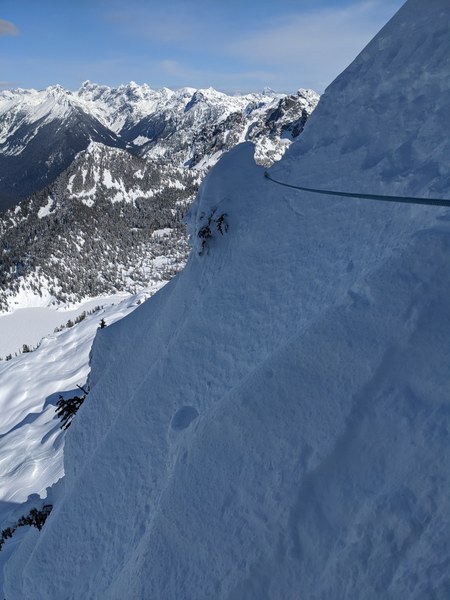
Getting close enough to the trees to build an anchor was tricky, since the slope was rather steep, and I knew that the snow around the trees was loose. It didn't help that the rope got tight, and I couldn't tell if I run out or it was just the rope drag confusing my belayer because the radio has broken again:
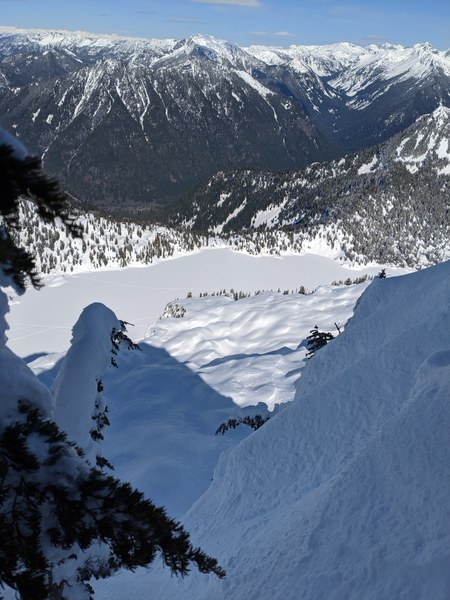
Finally success, the third pitch was over, and I was going to live another day:
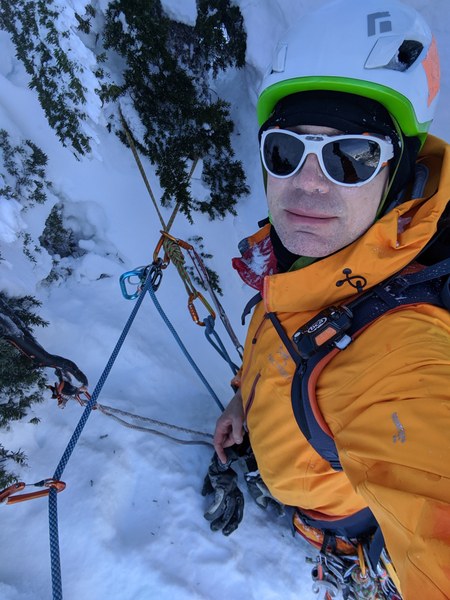
As I was struggling on my way up, the other team learned from my mistake and took the right line towards the summit. They ended up bypassing us and getting up at least an hour faster.
Bringing my second up took a bit, but not as long as I was worried it might. Since he observed me from belay, he had beta to work with and managed to execute the same sequence.
The fourth and final pitch was reasonably uneventful. The condition of the snow required moving carefully and tentatively in a few places, and we placed only one picket that wouldn't hold, but we executed it relatively quickly.
The only thing that slowed me down on this pitch was the icicles that formed around the fingers of my gloves. I had to take off gloves, rub and warm my fingers a couple times on my way up, as I was concerned about getting frostbite. The gloves served me well in Bozeman, but apparently weren't a match for the North Face of Chair. Good to know. Later on, I switched to a pair of OR Bitterblaze and I was a happy camper.
Topped out on the summit around 4:30pm, a good 2.5 hours behind the schedule. Yikes! At least a part of it was getting off route, but even if we didn't, this climb in the present conditions would've still taken at least an hour longer than I anticipated.
Some say the North Face is easier than the Northeast Buttress. Having climbed both routes in the course of a week, I must disagree. It may be true if the conditions are right, but in the conditions that we experienced, with scarce pro and loose snow, the climbing was much slower. I believe the poorly-protectable nature of this climb would make it inherently harder to most climbers. Steep loose snow has felt to me far more challenging than the body-length ice step on Northeast buttress that may have been vertical or near-vertical, but that offered solid tools sticks and good feet.
Given that we were behind schedule, we didn't stay long around the summit, but still managed to snap a few pics:
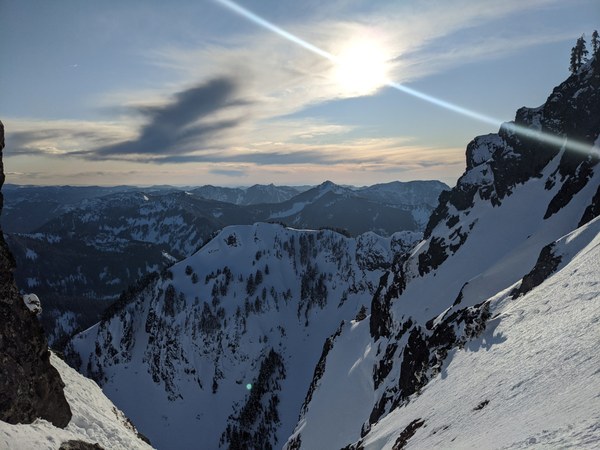
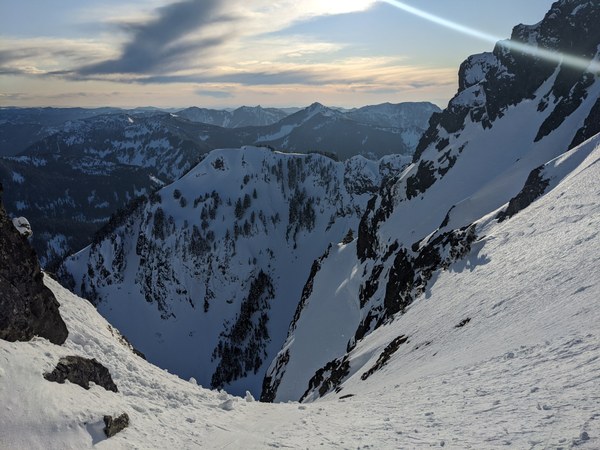
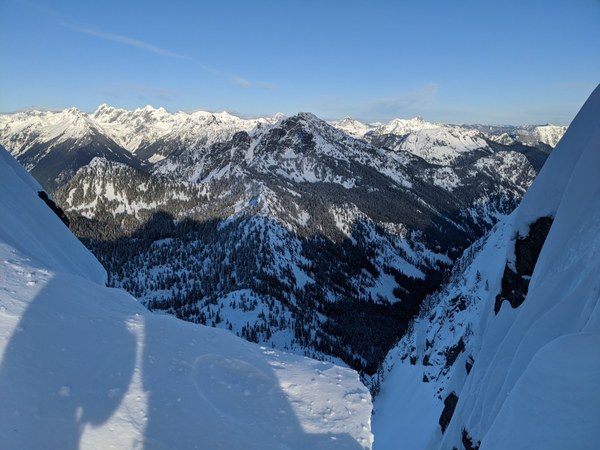
We started descent from the summit around 5pm. Initially, I thought we'd downclimb, just like we've done after the Northeast Buttress climb the preceding weekend. But, the quality of the snow this time was inferior, and the group wasn't comfortable soloing the steep downclimb. Hence, we decided to go down the other gully next to the summit traverse, left and around the corner to a group of trees, from which around 5:30pm we started the first double-rappel, to get to the second rappel with the three rusty pitons. On our way down the initial rappel, we managed to get the rope stuck, and one of us had to climb halfway back up to get it unstuck.
Looking back at the stuck rope:
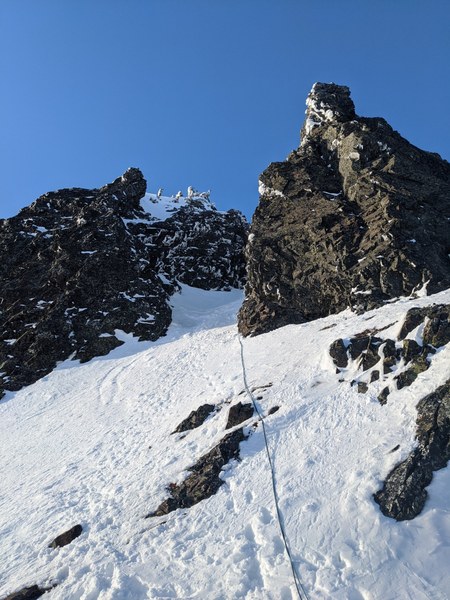
With two teams doing two double-rope rappels in sequence, rappeling took a while, in total about 2.5 hours to get down, downclimb to gear stash, and pack out.
Finally, by around 8pm everyone was packed and ready, and we started our descent. As the sunset was 7:20pm, it was already dark, so we were heading out by headlamps, just as we hiked in. Down to the cars around 9:45pm, for a total of about 16.5 hours car to car.
Overall, this was a great adventure. We were heading into the unknown, and there were some cold and a few gnarly moments after getting off route.
At first, I thought I'd give it a 3-star rating and swear to never do it again, but I'm blessed with a poor memory of past suffering.
Would I do it again? Definitely.
 Krzysztof Ostrowski
Krzysztof Ostrowski